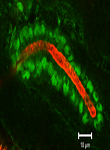|
|
|
Tubulogenesis – Microtubules Make the Move
|
|
|
|
|
|
|
|
|
|

|
|
|
|
Rajprasad Loganathan, PhD
|
|
|
|
Johns Hopkins University
|
|
Department of Cell Biology, JHMI, 725 N. Wolfe Street, 114 WBSB, Baltimore, MD 21205, USA
|
|
rlogana2@jhmi.edu
|
|
|
|
|
|
|
|
|
|

|
|
Invagination is a key morphogenetic event in the generation of epithelial tube architectures.The driving force for cell shape changes that enable coordinated invagination is provided by the cytoskeleton. Much has been learned about the dynamics of actomyosin - as drivers of cell shape changes, particularly apical constriction - during invagination. However, the role of microtubules has not been clear. In a recently published study, Booth et al. describe the dynamics of microtubule during morphogenesis of a tubular organ (the salivary glands) in the Drosophila embryo. The authors observed both a 90°change in microtubule orientation relative to the cellular apicobasal axis and a loss of centrosomal attachment coincident with tube formation of cells fated to form the salivary glands. They showed that targeted disruption of the microtubule cytoskeleton leads to a failure of invagination by destabilization of the medial actomyosin network, a driver of apical constriction. The study also suggests that a cytolinker protein - Shot - linksthe microtubule bundles with the medial actomyosin network.
|
|
|
|
|
|
|
|

|
|